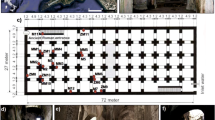Abstract
The main object of investigations in this work is the study of the various Roman mortars in Drobeta-Turnu Severin, Romania; the results help clarify the technology used for the construction of the studied sites through different thermoanalytical techniques. The first site encompasses the surviving elements of the Danube Bridge built by the Romans at the beginning of the second century AD to help in their conquest of Dacia. The aim is to establish the extent of similarity or difference between the studied samples. Thermal analysis and infrared spectroscopy are used in the study of different mortar samples. This paper highlights the compatibility of the techniques used: XRD for identifying major crystalline phases, FTIR for a more detailed image for the noncrystalline phase composition and TGA for a quantitative determination of volatile phases (especially CO2 and H2O). The analyses carried out on the mortar samples managed to divide the samples into different categories, obtaining very good correlations between the techniques used. The results also indicate that mortar samples from both the bridge and the Roman Castrum are within known values for Roman mortars.






Similar content being viewed by others
References
Vittorio GI. Ponti romani. Catalogo generale, vol. 2. Treviso: Edizioni Canova; 1994.
Griggs FE Jr. Trajan’s bridge: the world’s first long-span wooden bridge. Civil Engineering Practice. 2007;22(1):19–50.
Nemțeanu R. Trajan’s bridge at Drobeta-Turnu Severin built by the architect Apollodorus. ARA Rep. 2011;2:113–26.
Moşoiu C, Vlase D, Vlase G, Lazău R, Vlase T. TG-DTA and FTIR analyses of roman and later historic mortars from Drobeta-Turnu Severin region. J Therm Anal Calorim. 2019;138(3):2159–66.
Silva DA, Wenk HR, Monteiro PJM. Comparative investigation of mortars from Roman Colosseum and cistern. Thermochim Acta. 2005;438:35–40.
Duran A, Perez-Maqueda L, Poyato J, Perez-Maqueda J. A thermal study approach to roman age wall painting mortars. J Therm Anal Calorim. 2010;99:803–9.
Vecchio S, La Gmestra A, Frezza A, Ferragina C. The use of thermoanalytical techniques in the characterization of ancient mortars. Thermochim Acta. 1993;227:215–23.
Biscontin G, Pellizon Birelli M, Zendri E. Characterisation of binders employed in the manufacture of Venetian historical mortars. J Cult Herit. 2000;3:31–7.
Anastasiou M, Hasapis T, Zorba T, Pavlidou E, Chrissafis K, Paraskevopoulos KM. TG-DTA and FTIE analyses of plasters from byzantine monuments in Balkan region-comparative study. J Therm Anal Calorim. 2006;84:27–32.
Catauro M, Bollino F, Dell’Era A, Ciprioti SV. Pure Al2O3· 2SiO2 synthesized via a sol-gel technique as a raw material to replace metakaolin: chemical and structural characterization and thermal behavior. Ceram Int. 2016;42(14):16303–9.
Catauro M, Papale F, Lamanna G, Bollino F. Geopolymer/PEG hybrid materials synthesis and investigation of the polymer influence on microstructure and mechanical behavior. Mater Res. 2015;18:698–705.
Dambrauskas T, Baltakys K, Eisinas A. Formation and thermal stability of calcium silicate hydrate substituted with Al3+ ions in the mixtures with CaO/SiO2 = 1.5. J Therm Anal Calorim. 2018;131:501–12.
Kani EN, Allahverdi A, Provis JL. Calorimetric study of geopolymer binders based on natural Pozzolan. J Therm Anal Calorim. 2017;127:2181–90.
Zhi Z, Ma B, Jian S, Guo Y, Yu H, Tan H, Chen F. Thermal analyses. Effect of cellulose ethers on hydration of high-strength gypsum. J Therm Anal Calorim. 2017;129:1547–54.
Scheinherrova L, Dolezelova M, Havlın J, Trnık A. Thermal analysis of ternary gypsum-based binders stored in different environments. J Therm Anal Calorim. 2018;133:177–88.
Bakolas A, Biscontin G, Moropouloub A, Zendri E. Characterization of structural byzantine mortars by thermogravimetric analysis. Thermochim Acta. 1998;321:151–60.
Gaviria X, Borrachero MV, Paya J, Monzo JM, Tobon JI. Mineralogical evolution of cement pastes at early ages based on thermogravimetric analysis (TG). J Therm Anal Calorim. 2018;132:39–46.
Vlase D, Rogozea O, Moşoiu C, Vlase G, Lazău R, Vlase T. Thermoanalytical investigations of some ceramics dated from the Neolithic period, discovered at Oxenbrickel, Sânandrei, Romania. J Therm Anal Calorim. 2019;138:2145–57.
Acknowledgements
We would like to thank archaeologists Marin Neagoe, PhD, and Oana Neagoe, PhD, from Museum of the Iron Gates Region, for providing the samples.
Author information
Authors and Affiliations
Corresponding authors
Additional information
Publisher's Note
Springer Nature remains neutral with regard to jurisdictional claims in published maps and institutional affiliations.
Rights and permissions
About this article
Cite this article
Vlase, D., Codruţa, M., Vlase, G. et al. Comparative analyses of Roman mortars belonging to different ancient periods from Drobeta-Turnu Severin region. J Therm Anal Calorim 141, 991–998 (2020). https://doi.org/10.1007/s10973-020-09917-z
Received:
Accepted:
Published:
Issue Date:
DOI: https://doi.org/10.1007/s10973-020-09917-z




